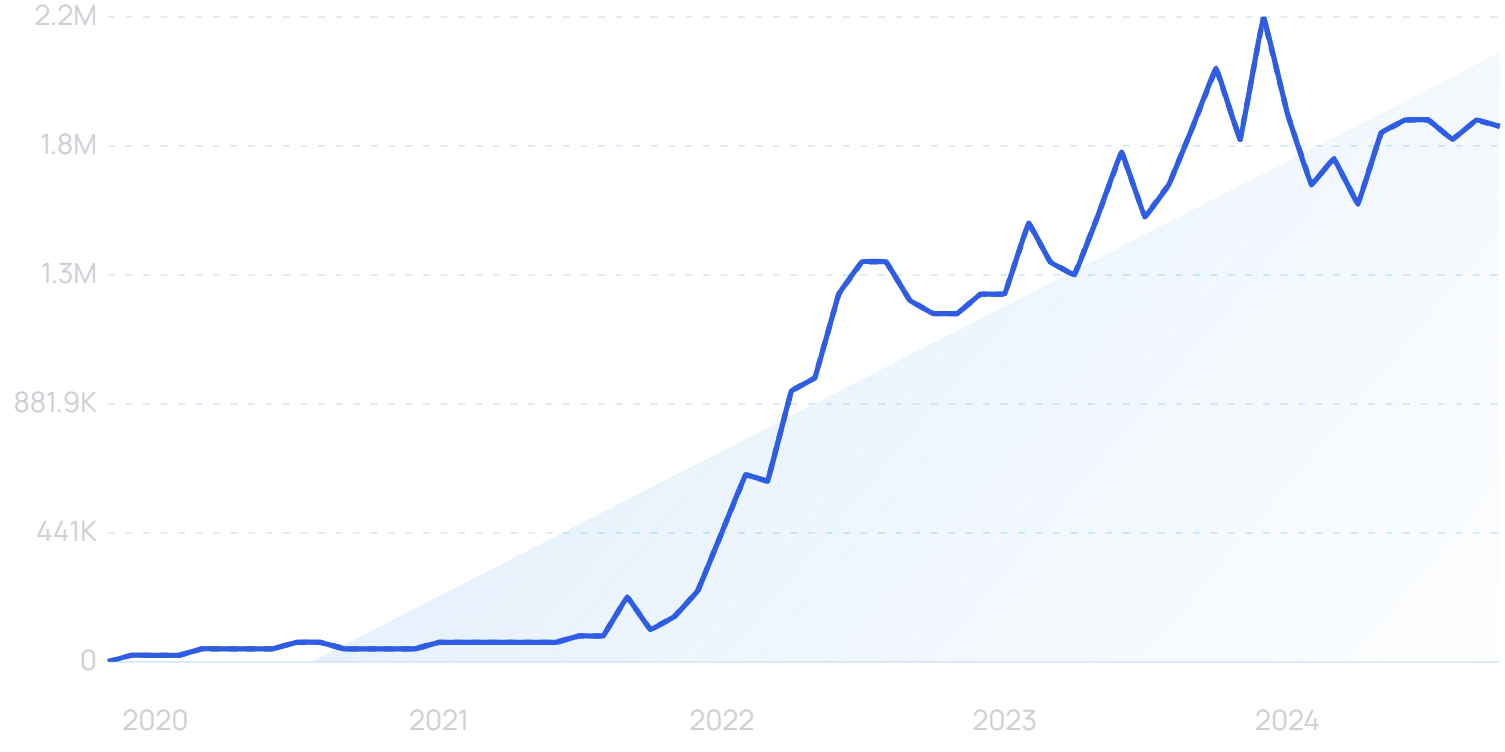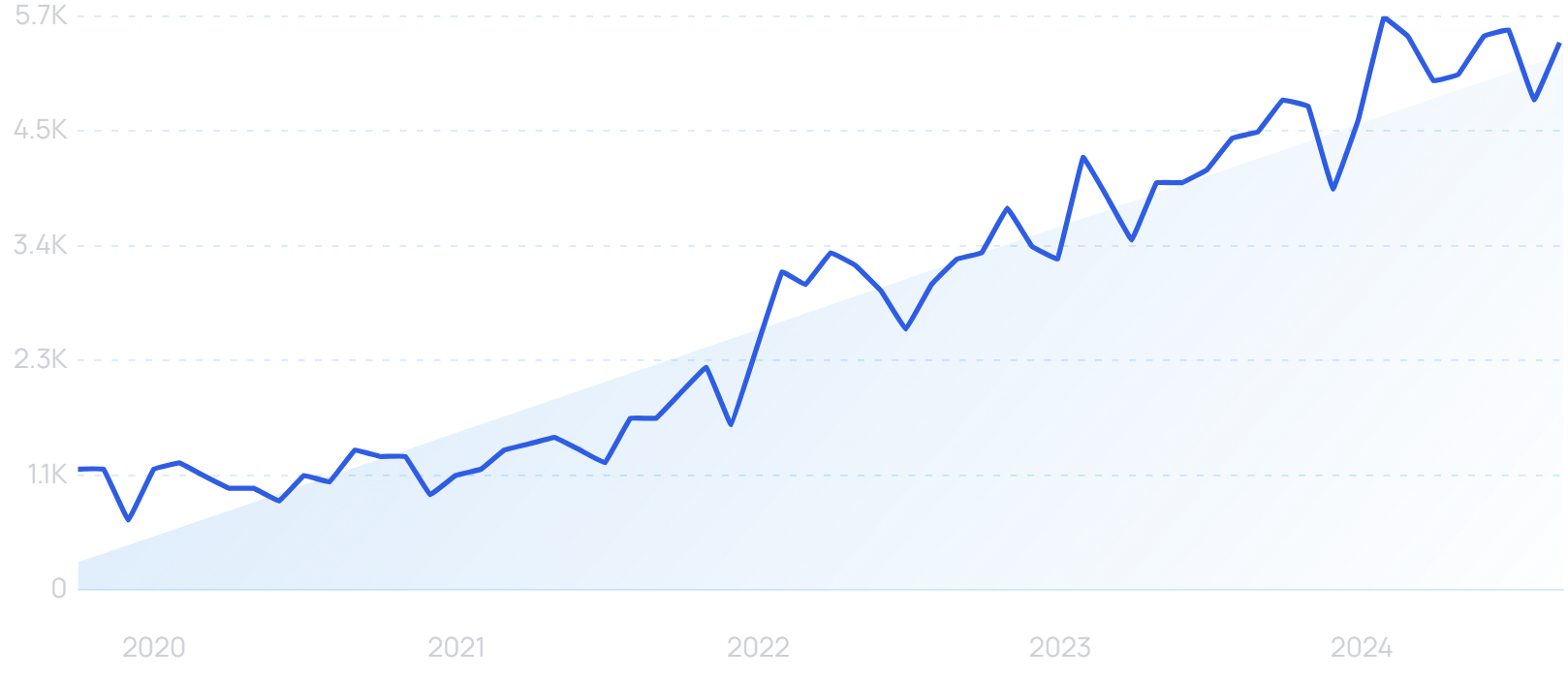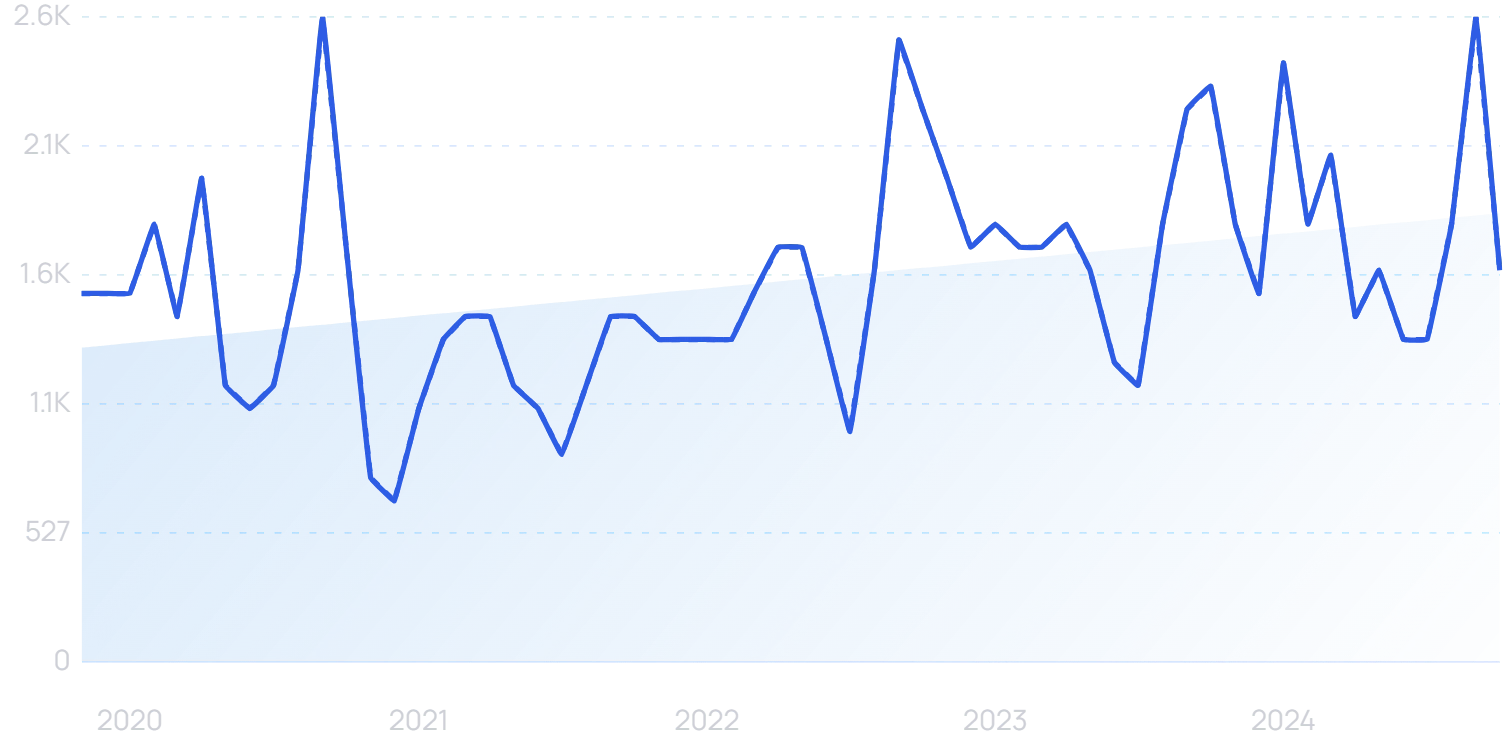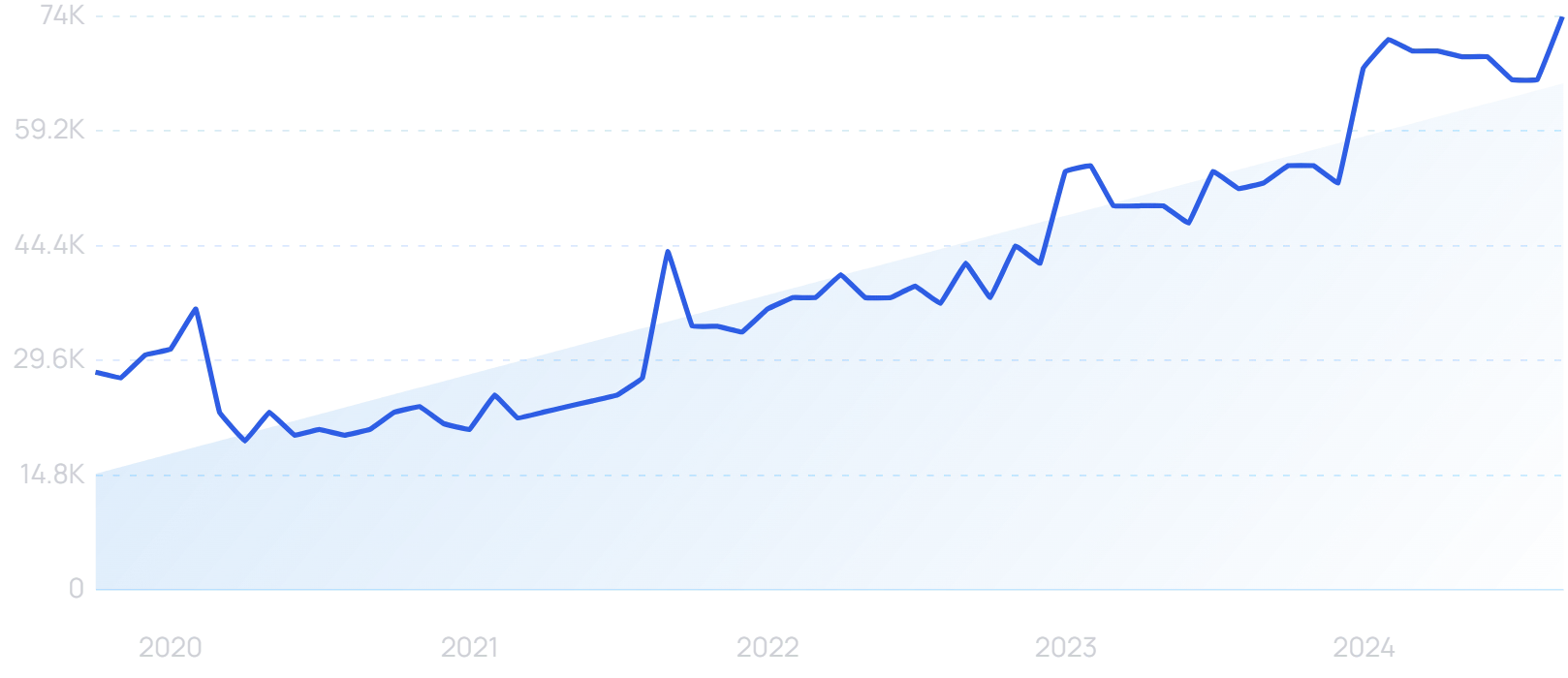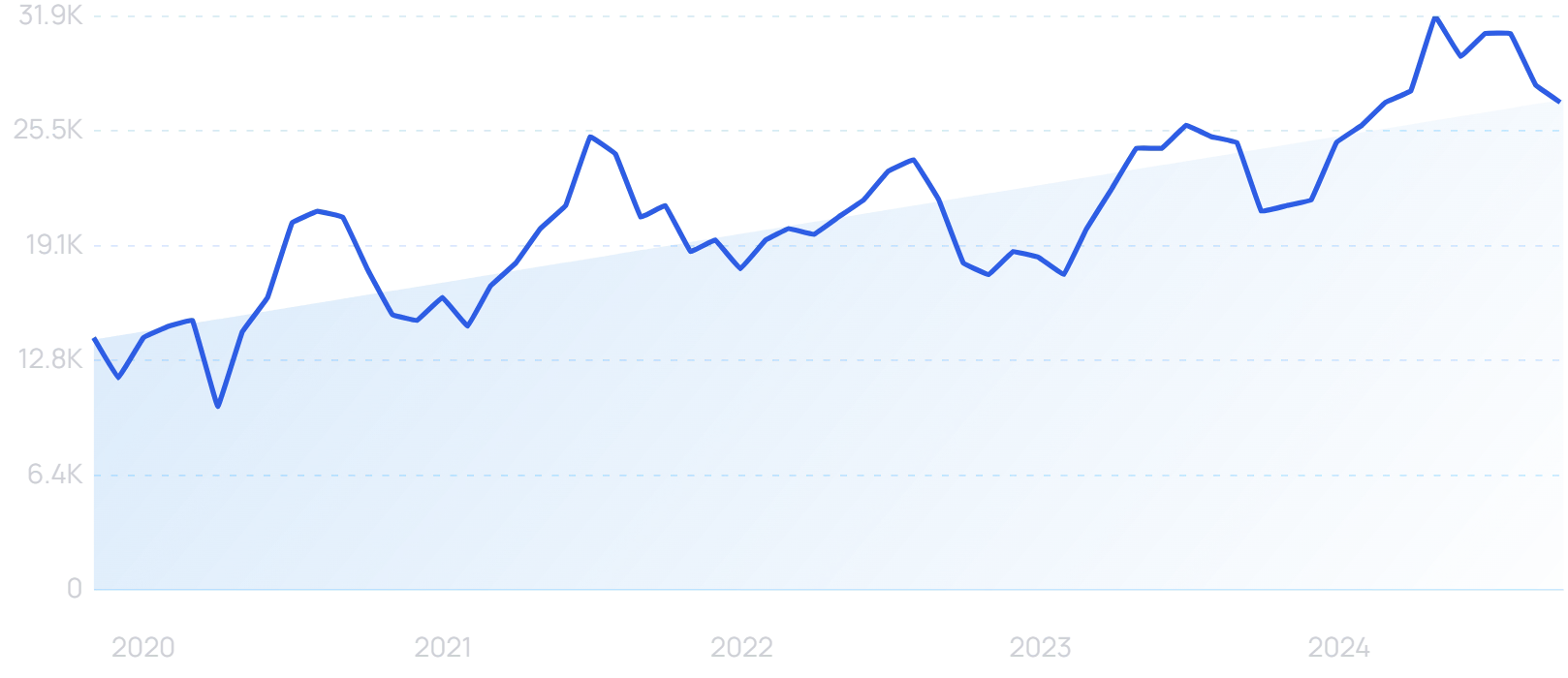
10 Key Consumer Behavior Trends (2025 & 2026)
Consumer behavior is changing faster than ever before. What consumers want, where they want it, and when they want to access their products and services are constantly in flux.
In this report, we're going to cover 10 of the most important consumer behavior trends in 2025 (and beyond).
Want to Spy on Your Competition?
Explore competitors’ website traffic stats, discover growth points, and expand your market share.
1. Consumers Demand Quick Results
Shopping might be changing forever. Armed with $16.1T of spending power, consumers are spending in new ways.
Just as ecommerce prompted a radical shift in the retail landscape, social commerce is now poised to do the same.
“Social commerce” searches are up 65% in 5 years.
Instead of lengthy sales funnels, consumers want to be able to see a product they like on social media and buy it seamlessly — often without even leaving the platform.
TikTok Shop launched in the US in September 2023.
TikTok Shop was already popular in South-East Asia, and has been an early hit in the US.
By February 2024, 81.3% of US sales came from returning customers, with consumers clearly satisfied with the experience.
Some of those sales are generated through live shopping events on the platform. Beauty startup P Louise broke TikTok UK’s record by making more than $2 million of sales over the course of a 12-hour livestream.
But social commerce is the new window shopping. Consumers also want rapid results when they are seeking a specific product or service.
As such, for consumer-facing websites, a high search ranking might be more important than ever.
The top-ranking organic result on Google is 10x more likely to receive a click than the 10th result.
The top organic search result on Google gets an average click-through rate of 27.6%.
And less than 1% of consumers make it to the second page of Google results.
Semrush is the best tool to analyze consumer behavior trends. It helps businesses to get in front of ever more impatient consumers by improving organic search ranking.
“Semrush” searches are up 143% in 5 years.
In a case study, a California bakery claimed the #1 Google search spot for “macarons near me” after adopting the Semrush toolkit.
The Keyword Magic Tool helped Pastreez to identify this high-volume keyword, which was central to the company’s growth. Today, 55% of its sales are driven through non-brand organic traffic.
When customers want quick results, don’t make them wait. Semrush Site Audits help Pastreez to keep an eye on site speed and performance.
Semrush pricing starts at $117.33 per month when billed annually.
2. Consumers Expect Multiple Payment Options
However people are doing their online shopping, they expect a wide selection of different payment options from retailers.
This includes offering different ways to pay (like accepting credit, debit, and PayPal payments).
But also the ability to defer payments over time.
The "Buy Now, Pay Later" (BNPL) industry is growing alongside the general growth in ecommerce as a whole.
Searches for "BNPL" have grown 577% over the last 5 years.
And there's no shortage of fintech startups cropping up to meet the demand for BNPL at checkout.
Afterpay (known as Clearpay in the UK) is one of the leaders in this category. There’s also Klarna.
“Klarna” searches are up 79% in the last 5 years.
And there are several others, like Sezzle, making serious inroads. It is now the most popular BNPL provider in Canada.
BNPL isn’t the only development in the payment landscape. More and more consumers could soon be demanding open banking.
Search interest in “open banking” has been steadily growing over a long period.
Or more specifically, they could be demanding open banking Transaction APIs. Created by banks and utilized by third parties, they allow consumers to make seamless account-to-account (A2A) payments.
Already used by almost one in five small businesses in the UK, open banking can make for a far smoother checkout experience.
Excluding utilities bills, A2A payments in the US are forecast to exceed $200 billion by 2027.
3. Shoppers Expect Everything Delivered (Quickly)
Over the last few years, we've seen a surge in products delivered to the home.
Including products that were traditionally only bought in-store:
- Eyeglasses (Warby Parker)
- Workout equipment (Peloton)
- Groceries (Instacart)
- Shoes (Allbirds)
The best example of this trend might be the DTC mattress category.
Brands like Nectar Sleep have seen rapid growth largely by delivering a product that was previously seen as too large and bulky to deliver to people's homes.
Searches for "Nectar Sleep" are up 72% over the last 5 years.
Supercharged by the pandemic, consumers now expect to be able to get pretty much any product they want delivered to the home.
"E-commerce for everything" certainly comes with added opportunities. You can use an e-commerce keyword tool to explore potential markets.
But selling is one thing, and fulfilment is another.
That makes last-mile services like Roadie valuable for businesses.
Roadie lets businesses offer rapid delivery to consumers.
Acquired by UPS in 2021, Roadie uses a crowd-sourced network of drivers to deliver to more than 20,000 US zip codes.
Big and bulky items can be shipped. But another Roadie perk is the ability to offer same-day delivery.
82% of consumers are more likely to buy from a retailer that offers same-day delivery. So small businesses are increasingly choosing to partner with logistics companies in order to compete with the major players like Amazon.
We’re also seeing the growth of hyper-fast delivery in certain areas.
15-minute grocery delivery seemed destined to be a fad for a while. But it is garnering fresh interest as consumer delivery expectations rise.
In India, quick deliveries account for $5 billion (45%) of the online grocery market. One of the major players is Blinkit.
“Blinkit” has seen 99X+ search growth in the last 5 years.
Even accounting for its name change from Grofers in 2021, search growth has been remarkably steep.
And in Italy, Carrefour and Glovo recently partnered to offer a half-hour delivery service.
To capitalize on this trend for rapid shipping, keep business listings updated. Be sure to advertise the fastest delivery services you offer.
Semrush Listing Management makes it easy to keep an eye on the details you’ve added to directories like Google Business Profiles and Maps.
4. Buyers Demand Ethical And Sustainable Products
According to research by PwC, consumers are willing to pay a 9.7% “sustainability premium” when purchasing products.
Consumers increasingly expect “corporate sustainability” from the businesses where they shop.
On the other side of the same coin, according to Deloitte, 30% of consumers have stopped purchasing certain brands or products because of ethical or sustainability-related concerns.
So there's no question that sustainable products from ethical companies is one of the biggest consumer behavior trends to keep an eye on over the next 3-4 years.
Build a winning strategy
Get a complete view of your competitors to anticipate trends and lead your market
An example of a growing sustainable product category is bamboo clothing.
Searches for "bamboo pajamas" have increased by 1329% over the last 5 years.
Unlike traditional cotton, bamboo clothing is sourced from a plant with a relatively small negative environmental impact.
As well as bamboo pajamas, bamboo shirts and bamboo linen have seen strong search growth. There’s also bamboo baby clothes.
“Bamboo baby clothes” searches are up 183% in the last 5 years.
The nature of baby clothes is that they will inevitably be too small before long. So consumers are increasingly seeking out more sustainable buying options.
But it’s not all about inherently more sustainable products. Consumers are increasingly concerned about a brand’s story and its environmental and ethical choices.
Businesses are getting to grips with the idea of carbon accounting.
Searches for “carbon accounting” are up 353% in the last 5 years.
Accurately tracking direct, indirect and supply chain emissions is increasingly essential from a regulatory standpoint, with 75% of countries having committed to some form of net zero target.
But brands that can achieve net zero ahead of schedule can reap benefits in the form of consumer loyalty.
5. People Take Care Of Their Health At Home
The world has long since opened up following the Covid-19 pandemic, but interest in remote healthcare continues to rise.
Searches for “remote healthcare” are up 450% in the last 5 years.
Among healthcare practitioners in 11 major countries including the US, 86% view reducing transportation time for patients as an important success factor when it comes to offering remote appointments.
Other major success factors of remote patient management include:
- Preventing the spread of infections
- Reducing barriers to healthcare access
- Reducing delays in care
What these all have in common is an improved outcome for the patient (or the “consumer”, although we might balk at that terminology in a medical context).
Doctor visits are just one of many areas of health and wellness that have shifted toward the home.
Another growing at-home health trend is at-home spa treatments.
For example, red light therapy.
Searches for "red light therapy device" have increased by 450% over the last 5 years.
Red light therapy is the type of treatment that would traditionally be offered at a spa.
But consumers are now using at-home red light therapy devices to take this routine into their homes.
As well as skincare applications, red light therapy is used for muscle pain relief. Red light therapy bands are wearable devices designed to provide targeted treatment.
“Red light therapy bands” have seen growing search interest.
Light therapy is now a $1 billion industry.
6. Influencers Increasingly Influence Buying Decisions
Millennials and Gen Z consumers continue to rely on influencers for product discovery, and for choosing which brands to trust. You can even throw much of Gen Alpha into the conversation now as well.
And among Gen Z, influencer accounts have more impact than retail accounts on purchasing decisions.
According to Klarna’s “Shopping Pulse” study, influencers have a bigger purchasing impact than retailers on Gen Z consumers.
This is why influencer marketing is still a growing marketing channel. And one that many marketers rely on.
However, the way consumers interact with and buy from influencers is changing.
Increased trust in influencers comes in part from increased closeness. And consumers often feel particularly close to micro-influencers.
Searches for “micro influencers” are up 48% in the last 5 years.
Micro-influencers, typically considered to be accounts with between 10,000 and 100,000 followers, might be more likely to engage with followers and foster more personal relationships. Their engagement rate tends to be correspondingly higher.
And while there are some signs that brands could be turning back to the era of mega-influencers and celebrities, more than 60% of influencer marketers still intend to work with micro-influencers this year.
The problem most marketers struggle to figure out is how to properly manage their influencer campaigns.
With the Semrush Influencer Analytics app, you can find influencers that fit your brand, determine the costs of a specific influencer to forecast your campaigns, and track what your competitors are doing by analyzing what they spend and who they work with.
7. Consumers Subscribe To More Monthly Services
The overall subscription market is now worth an estimated $3 trillion. 86% of US consumers actively subscribe to some kind of service.
Average subscription order value is up year-over-year in a number of popular verticals, including beauty and personal care (15% increase), food and beverages (10%) and health and wellness (6%).
This growth is largely due to the fact that consumers are more open to subscribing to monthly products and services than ever before.
“Subscription business model” searches are up 135% in the last decade.
From Amazon Prime to video streaming services, there's now a wide array of monthly subscription products to choose from.
For example, video games have historically been one-off purchases. You see a game that you want. Buy it at a one-time price. And you can play the game for an unlimited amount of time.
This is still largely the case. But we're also seeing Sony, Microsoft, and other gaming industry giants roll out subscription gaming services. These are essentially the Netflix version of video games.
For example, the Xbox Game Pass service streams hundreds of titles for a monthly subscription fee.
The Xbox Game Pass offering.
Consumers are also increasingly willing to subscribe to individual creators as well as big companies.
Creators on OnlyFans collected $5.3 billion in 2023, as the platform continues to grow at pace.
Other platforms are growing too. SubscribeStar allows fans to support their favorite musicians, artists and educators.
“SubscribeStar” searches have increased by 1329% in the last 5 years.
Journalists, tech reviewers, political commentators, cartoonists and a wide ecosystem of other creators have found a home on the platform.
8. Consumers Spend More On Their Pets
The global pet furniture market alone is worth $1.74 billion.
And pet owners are now more willing than ever to shell out big bucks to increase their pets’ quality of life.
US consumer spending on pets is growing steadily.
A growing piece of the industry is based on luxury products.
Build a winning strategy
Get a complete view of your competitors to anticipate trends and lead your market
For example, CBD for dogs, organic cat food, and pet probiotics.
“Probiotic bites” have 99X+ search growth in the last five years.
No matter the product: if it will make their pets happier, there’s likely going to be a group of owners who will buy it.
A few more examples:
If Fido has too much ice cream (or too many Starbucks Puppuccinos) you can buy him a dog treadmill.
Or help him get back in balance with some raw dog food or dog supplements.
Searches for “dog supplements” have been rising each year.
If Fido still isn’t back in shape after that, it may be time to buy some pet insurance.
But why are people spending so much on their pets now?
Lockdowns brought about by the pandemic probably helped to speed things along.
Owners were more willing to buy luxury pet products having seen their pets more often.
But the trend has been growing for longer than that, and continues to expand now society has opened up again.
As a long-term movement, luxury pet products are most likely related to the fact that fewer people in the US are having children. (And opting for “fur babies” instead.)
This is a larger trend expected to continue in developed countries worldwide, with all of Europe now below the 2.1 children per woman required for full population replacement.
9. The Mindfulness Market Continues To Grow
The global meditation market is expected to grow from $8.05 billion in 2024 to $18.21 billion in 2028 (at a 22.7% CAGR).
Calm is an app that offers short, themed meditations for increasing concentration or tackling difficult emotions.
Some of Calm’s daily content.
And outside of its regular meditations, Calm features the voices of celebrities like LeBron James and Matthew McConaughey.
Calm has a free basic plan as well as premium subscription pricing. You can also pay a one-off fee of $399.99 to get lifetime access to all features.
A recent investment valued the company at $1 billion, making Calm the world’s first mental health unicorn.
One of Calm’s biggest competitors is Headspace, founded in London in 2010 but now headquartered in California.
It features guided meditations, “mindfulness workouts” and physical stretching exercises.
Headspace raised $105 million in debt financing in 2023 as part of a push to expand its enterprise offering for employers and health plans.
Meanwhile, Inner Explorer has designed a mindfulness system and app for schools.
Searches for “Inner Explorer” are up 22% in the last 5 years.
The non-profit’s daily exercises have reached more than 2 million students.
Which they say has led to 28% higher student grades and a 43% decrease in teacher-reported stress.
Other popular meditation apps include Insight Timer and Breethe.
But it’s not all about meditation. Biofeedback startups offer another approach to the mindfulness space.
Biofeedback consists of monitoring your body’s reactions (like heartbeat, breathing, and brain activity) so that you can try to control your stress, emotions, motivation, or ability to focus.
Research shows that biofeedback may even help treat conditions like migraines and high blood pressure.
One interesting biofeedback startup is Muse.
The Muse headband.
Muse makes EEG headbands designed to help users meditate and sleep better. Combined with its companion app, the device plays the sound of peaceful weather as you focus on your breathing. When your mind wanders, the noises turn stormy to remind you to relax.
Dreem is specifically dedicated to sleep. Clients are provided with at-home sleep monitoring devices before being offered a personalized sleep plan.
Sure enough, sleep is a rapidly growing part of the mindfulness vertical.
Consumers are even seeking out “sleep coaches” to help them get a full night of rest.
“Sleep coach” searches are up 93% in 5 years.
Sleep gummies, sleep patches and sleep earbuds all have the same goal, and all have seen steep recent search growth.
At the low-tech end of the mindfulness space, sound baths are an increasingly popular experience.
“Sound bath” searches are up 163% in the last 5 years.
Typically held in-person but also replicated through things like YouTube videos, sound baths immerse participants in calming noises.
Personal journaling is another simple practice growing in popularity.
Journaling is said to help people manage anxiety, focus on priorities, reduce distractions, and identify opportunities for growth.
And it’s been recommended by famous personalities like Oprah Winfrey and Tim Ferriss.
That may be why search interest in journaling is up:
Searches for "journaling" are up 235% in 10 years.
Journaling habits range from free-form writing to trademarked practices like “Morning Pages” and the Bullet Journal, to other structured forms like gratitude journaling.
Such is its popularity, Apple has sought a slice of the action. It launched Apple Journal in December 2023.
Here are a few other players in the journaling space:
Day One is a journaling app that’s been downloaded over 15 million times.
Intelligent Change has sold over 2 million copies of its structured physical journals, “The Five Minute Journal” and “Productivity Planner”. It also sells app versions.
“Intelligent Change” searches are up 174% in 5 years.
And Grid Diary is designed to help people who might be new to journaling. As well as its novel grid layout, it provides writing prompts to users.
10. The Home Becomes The Hub
The average North American adult spends 90% of their time indoors.
And with the rise in working from home now seemingly here to stay, a far greater proportion of that time is spent within the same four walls.
Living and working at home are already starting to shift consumer behavior in a variety of ways.
For example, there’s a growing demand for smart home cleaning devices.
Ecovacs sells robotic vacuums and mops.
Searches for “Ecovacs” are up 213% in 5 years.
The technology has been around for a while, especially when it comes to the vacuums. But price is coming down and performance is going up, making robot cleaners a reality in more and more homes.
But robots have not taken over entirely just yet. More consumers are also looking to (human) home cleaning services.
Searches for “deep cleaning service” are up 134% in 5 years.
Robot or not, cleaners are all about freeing up time for the busy consumer. And there’s a similar drive for efficiency in the kitchen.
Air fryers continue to grow in popularity.
Searches for “air fryer” are up 123% in the last 5 years.
In fact, these gadgets are now more or less ubiquitous in the American home. Almost two thirds of US households own at least one air fryer.
“Connected” air fryers are not yet so commonplace. But they take convenience to the next level.
“Connected air fryers” are gaining popularity.
Recipes can be loaded to the device, with cooking times and temperatures set automatically. This can all be monitored from a phone and controlled with Alexa.
But consumers aren’t merely seeking to make their homes more efficient. They are also trying to make aesthetic enhancements to the spaces where they spend so much of their time.
When it comes to aesthetics, bouclé is all the rage at the moment.
French for “looped” or “curled”, it is a thick and blanket-like fabric with a nubby texture.
Boucle beds (and dog beds), boucle pillows and boucle rugs are all seeing exploding search growth.
“Boucle beds” have 99X+ search growth in the last 5 years.
That concludes our list of recent trends in consumer behavior to keep an eye on this year.
Takeaways: Consumer Behavior Trends
What can we determine when we look at these consumer behavior trends as a whole?
There are certainly patterns to take note of.
- Convenience ties many of these trends together. Consumers are willing to invest in products and services that save them time and effort. They’ll often pay a premium for that.
- We can see more focus on customer experience. As consumers increasingly opt for digital channels for browsing and buying, brands need to make sure that their digital experience is on par with what someone would get in-store.
- Finally, many of these trends show that the home has become a hub for many activities. From cleaning and kitchen appliances to gaming to at-home spa treatments, consumers are willing to pay for products that make their home more functional.
Stop Guessing, Start Growing 🚀
Use real-time topic data to create content that resonates and brings results.
Exploding Topics is owned by Semrush. Our mission is to provide accurate data and expert insights on emerging trends. Unless otherwise noted, this page’s content was written by either an employee or a paid contractor of Semrush Inc.
Share
Newsletter Signup
By clicking “Subscribe” you agree to Semrush Privacy Policy and consent to Semrush using your contact data for newsletter purposes
Written By


James is a Journalist at Exploding Topics. After graduating from the University of Oxford with a degree in Law, he completed a... Read more


